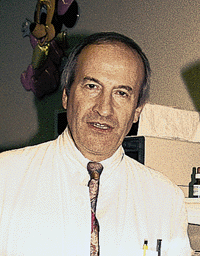
Prof. Dr. med.
SchachingerPaediatrician and Senior Consultant in the Neonatal unit
at the "Evangelisches Waldkrankenhaus", Academic Teaching Hospital of the
Berlin Free University
M E D I C A L
R E S O N A N C E T H E R A P Y M U S I
C® a product of the Micro Music Laboratories®
leading medicine into the future
application of the natural harmony laws of the microcosm of music in favour
of health
© A A R E D I T I O N I N T E R N A T I O N A L 2001

Prof. Dr. med.
SchachingerPaediatrician and Senior Consultant in the Neonatal unit
at the "Evangelisches Waldkrankenhaus", Academic Teaching Hospital of the
Berlin Free University
Prof. Dr.
med. Schachinger
I consider it is always important to point out that both branches of medical
care - the modern system of intensive medicine with many specialised devices
and highly developed medication on the one hand, and the empathetic guidance
and holistic harmonisation of the patients and their families on the other
- are linked to one another and must be brought into harmony.
Music therapy can provide an ideal link, but in a neonatal intensive care ward this can, of course, only be a so-called receptive music therapy - simply listening to healthpromoting music, not music making oneself. Throughout time, all civilisations have recognised the direct effect which music has on people's soul or mood and on their disposition, and that naturally structured music has an equalising, healing effect which can bring about a state of spiritual equilibrium for the individual.
Similarly,
it has been known from ancient times that, as well as a science, medicine
is also an art form responsible for the harmony and the order of the 'soul'.
Therefore, it is easy to see why this kind of medical application of music
by ancient high civilisations was one of medicine's most important corner
stones. Today, this very traditional medical-musical approach is being propagated
by the classical composer Peter Hübner. Here, based on modern scientific
research and development, he is working together with medical experts from
the most diverse of disciplines. We are also taking part in this research.
With our tiny patients (premature babies), we have been able to see how breathing
becomes calmer and more regular, breathing spaces less frequent and the thoracic
respiratory movements smaller and more even, due to this harmonising music.
The heart rate is also directly affected. To achieve this we play our 'little
ones' (as we call them) harmonic music. Here, we find that the Medical Resonance
Therapy Music by the composer Peter Hübner has a particularly calming and
restorative effect.
It does not surprise me then, that medical researchers in Belarus have had very good scientific results with this music and are now wishing to exploit its restorative quality as one of the most important preventative aids for their country's young victims of radioactive contamination.
The doctors have approached the music's composer, Peter Hübner, and asked him to do his utmost to enable as many of their young patients as possible to receive sustained help from his Medical Resonance Therapy Music. Thus, the sound creator Peter Hübner and his friends have started up an appropriate help campaign and they are looking to all of us for support.
![]()
Prof. Dr. med. Schachinger